Practice Free AZ-500 Exam Online Questions
HOTSPOT
You need to configure support for Azure Sentinel notebooks to meet the technical requirements.
What is the minimum number of Azure container registries and Azure Machine Learning workspaces required?
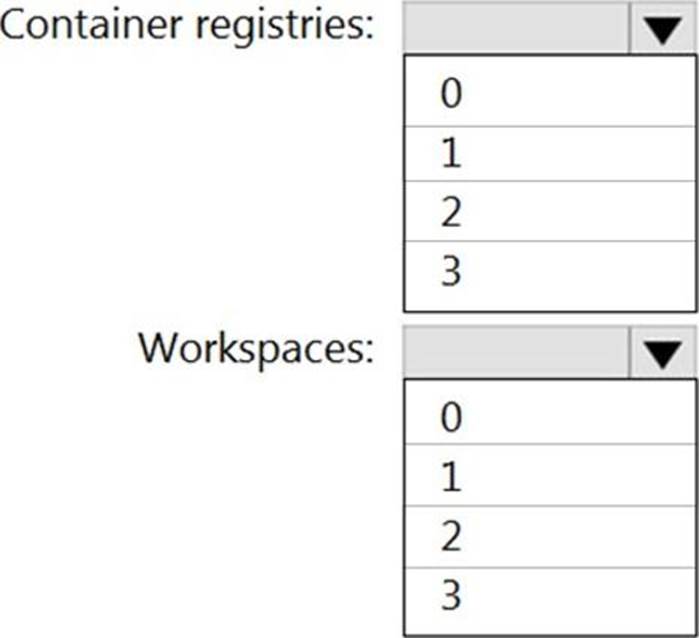
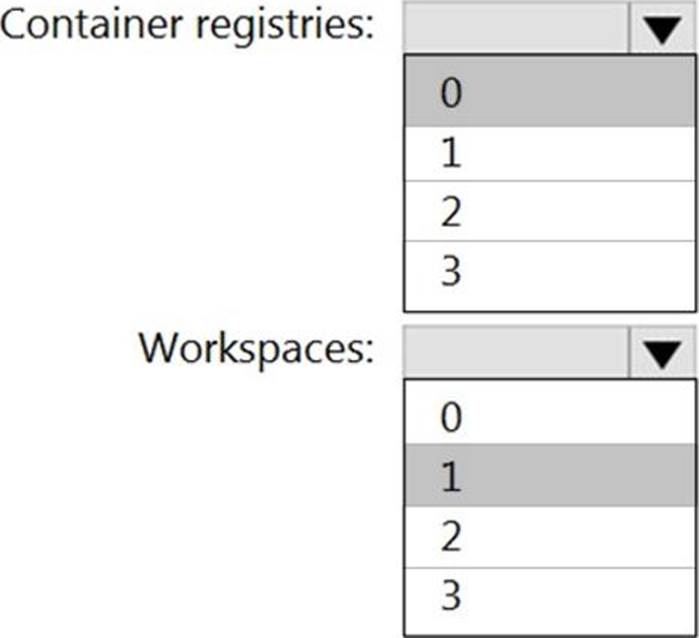
Explanation:
Reference: https://docs.microsoft.com/en-us/azure/sentinel/notebooks
HOTSPOT
You have an Azure subscription. The subscription contains Azure virtual machines that run Windows Server 2016.
You need to implement a policy to ensure that each virtual machine has a custom antimalware virtual machine extension installed.
How should you complete the policy? To answer, select the appropriate options in the answer area. NOTE: Each correct selection is worth one point.
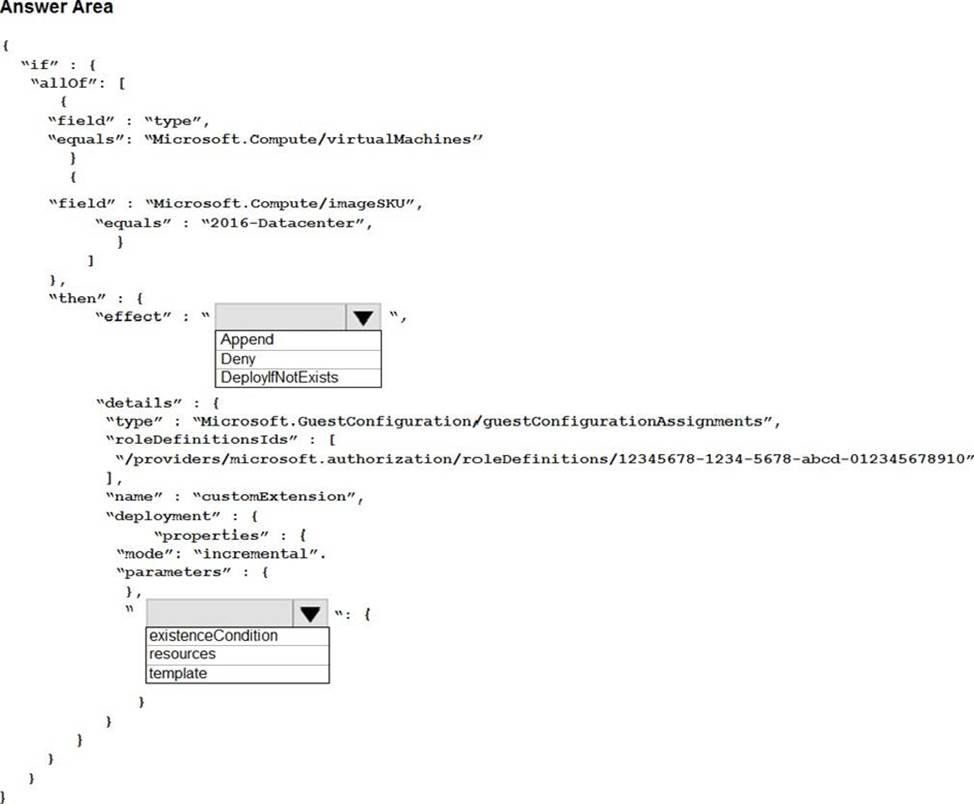
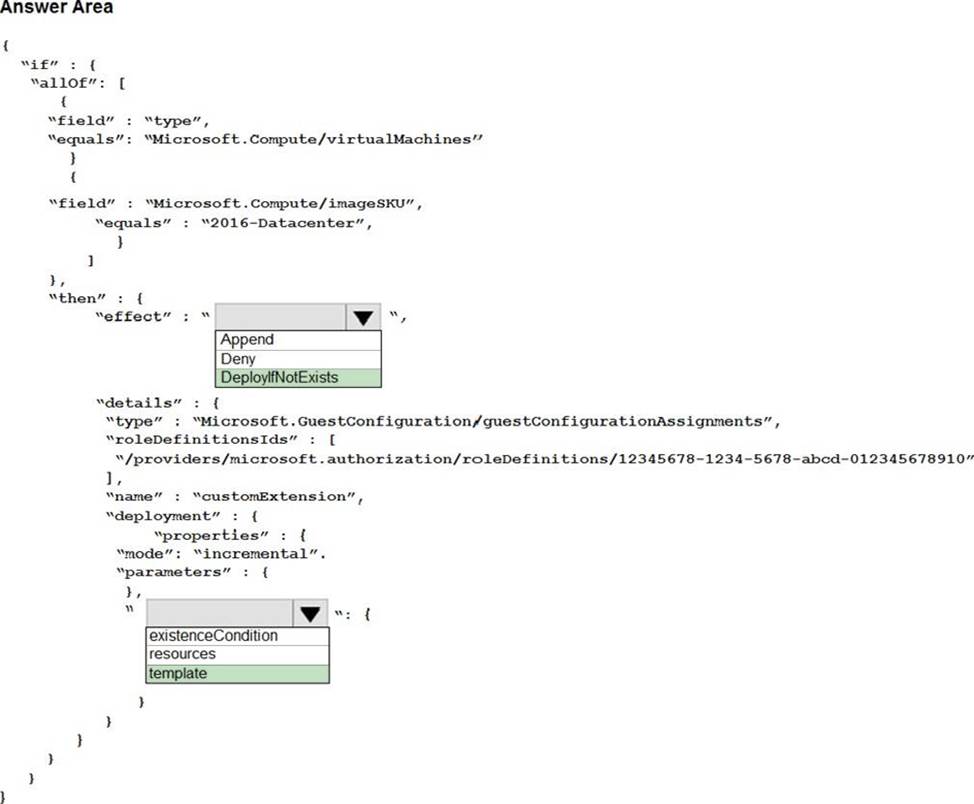
Explanation:
Box 1: DeployIfNotExists
DeployIfNotExists executes a template deployment when the condition is met.
Box 2: Template
The details property of the DeployIfNotExists effects has all the subproperties that define the related resources to match and the template deployment to execute.
Deployment [required]
This property should include the full template deployment as it would be passed to the Microsoft.Resources/deployment
Reference: https://docs.microsoft.com/en-us/azure/governance/policy/concepts/effects
Lab Task
Task 1
You need to ensure that connections from the Internet to VNET1subnet0 are allowed only over TCP port 7777. The solution must use only currently deployed resources.
You have an Azure subscription that contains an Azure Files share named share1 and a user named User1. Identity-based authentication is configured for share1.
User1 attempts to access share1 from a Windows 10 device by using SMB.
Which type of token will Azure Files use to authorize the request?
- A . OAuth 20
- B . JSON Web Token (JWT)
- C . Kerberos
- D . SAML
C
Explanation:
https://learn.microsoft.com/en-us/azure/storage/files/storage-files-identity-auth-active-directory-domain-service-enable?tabs=azure-portal
You have an Azure subscription that uses Azure AD Privileged Identity Management (PIM).
A user named User1 is eligible for the Billing administrator role.
You need to ensure that the role can only be used for a maximum of two hours.
What should you do?
- A . Create a new access review.
- B . Edit the role assignment settings.
- C . Update the end date of the user assignment
- D . Edit the role activation settings.
Topic 1, Litware, inc
This is a case study. Case studies are not timed separately. You can use as much exam time as you would like to complete each case. However, there may be additional case studies and sections on this exam. You must manage your time to ensure that you are able to complete all questions included on this exam in the time provided.
To answer the questions included in a case study, you will need to reference information that is provided in the case study. Case studies might contain exhibits and other resources that provide more information about the scenario that is described in the case study. Each question is independent of the other question on this case study.
At the end of this case study, a review screen will appear. This screen allows you to review your answers and to make changes before you move to the next sections of the exam. After you begin a new section, you cannot return to this section.
To start the case study
To display the first question on this case study, click the Next button. Use the buttons in the left pane to explore the content of the case study before you answer the questions. Clicking these buttons displays information such as business requirements, existing environment, and problem statements. If the case study has an All Information tab, note that the information displayed is identical to the information displayed on the subsequent tabs. When you are ready to answer a question, click the Question button to return to the question.
Overview
Litware, Inc. is a digital media company that has 500 employees in the Chicago area and 20 employees in the San Francisco area.
Existing Environment
Litware has an Azure subscription named Sub1 that has a subscription ID of 43894a43-17c2-4a39-8cfc-3540c2653ef4.
Sub1 is associated to an Azure Active Directory (Azure AD) tenant named litwareinc.com. The tenant contains the user objects and the device objects of all the Litware employees and their devices. Each user is assigned an Azure AD Premium P2 license. Azure AD Privileged Identity Management (PIM) is activated.
The tenant contains the groups shown in the following table.

The Azure subscription contains the objects shown in the following table.
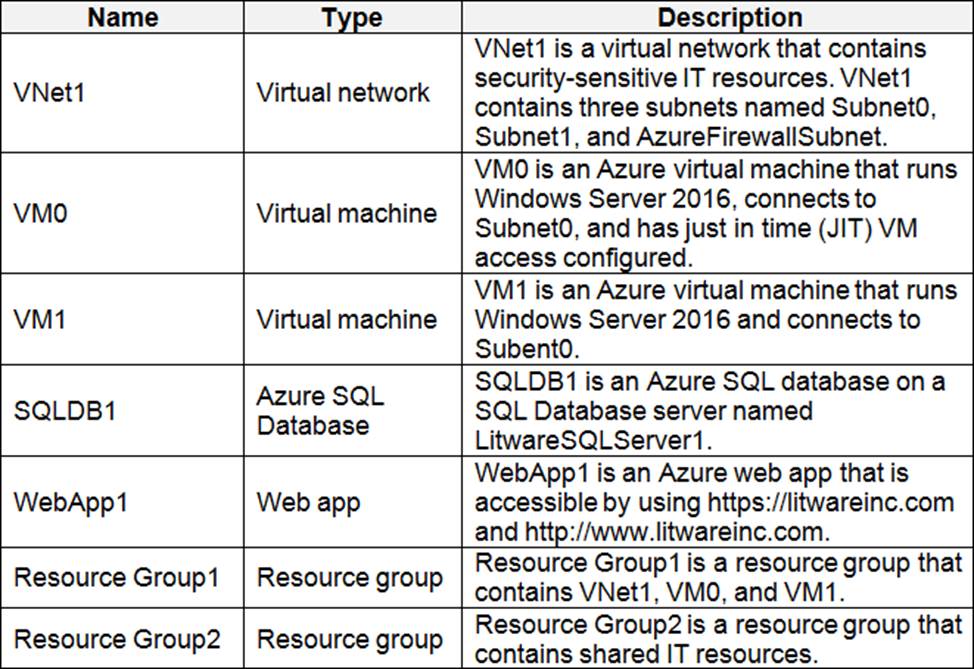
Azure Security Center is set to the Free tier.
Planned changes
Litware plans to deploy the Azure resources shown in the following table.

Identity and Access Requirements
Litware identifies the following identity and access requirements:
✑ All San Francisco users and their devices must be members of Group1.
✑ The members of Group2 must be assigned the Contributor role to Resource Group2 by using a permanent eligible assignment.
✑ Users must be prevented from registering applications in Azure AD and from consenting to applications that access company information on the users’ behalf.
Platform Protection Requirements
Litware identifies the following platform protection requirements:
✑ Microsoft Antimalware must be installed on the virtual machines in Resource Group1.
✑ The members of Group2 must be assigned the Azure Kubernetes Service Cluster Admin Role.
✑ Azure AD users must be to authenticate to AKS1 by using their Azure AD credentials.
✑ Following the implementation of the planned changes, the IT team must be able to connect to VM0 by using JIT VM access.
✑ A new custom RBAC role named Role1 must be used to delegate the administration of the managed disks in Resource Group1. Role1 must be available only for Resource Group1.
Security Operations Requirements
Litware must be able to customize the operating system security configurations in Azure Security Center.
You need to meet the identity and access requirements for Group1.
What should you do?
- A . Add a membership rule to Group1.
- B . Delete Group1. Create a new group named Group1 that has a membership type of Office 365. Add users and devices to the group.
- C . Modify the membership rule of Group1.
- D . Change the membership type of Group1 to Assigned. Create two groups that have dynamic memberships. Add the new groups to Group1.
D
Explanation:
https://docs.microsoft.com/en-us/azure/active-directory/users-groups-roles/groups-dynamic-membership
Scenario:
Litware identifies the following identity and access requirements: All San Francisco users and their devices must be members of Group1.
The tenant currently contain this group:

Reference: https://docs.microsoft.com/en-us/azure/active-directory/users-groups-roles/groups-dynamic-membership
https://docs.microsoft.com/en-us/azure/active-directory/fundamentals/active-directory-groups-create-azure-portal
HOTSPOT
You have an Azure subscription that contains an Azure SQL database named SQL1.
You plan to deploy a web app named App1.
You need to provide App1 with read and write access to SQL1.
The solution must meet the following requirements:
✑ Provide App1 with access to SQL1 without storing a password.
✑ Use the principle of least privilege.
✑ Minimize administrative effort.
Which type of account should App1 use to access SQL1, and which database roles should you assign to App1? To answer, select the appropriate options in the answer area. NOTE: Each correct selection is worth one point.
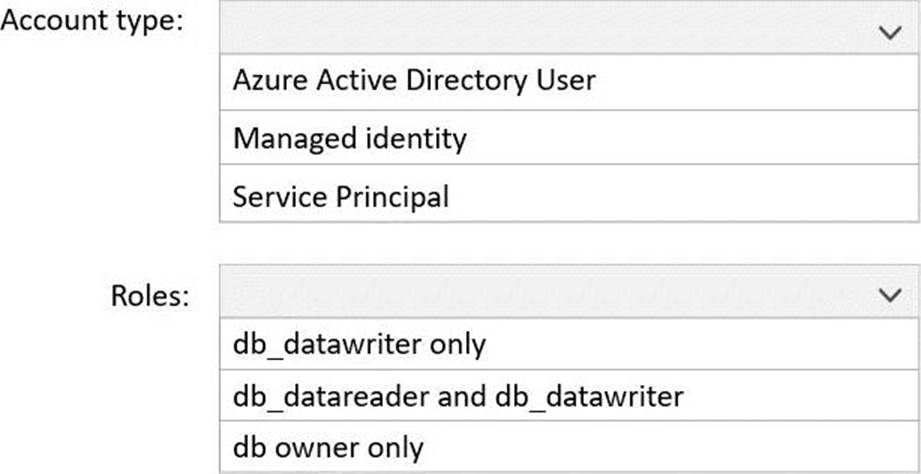
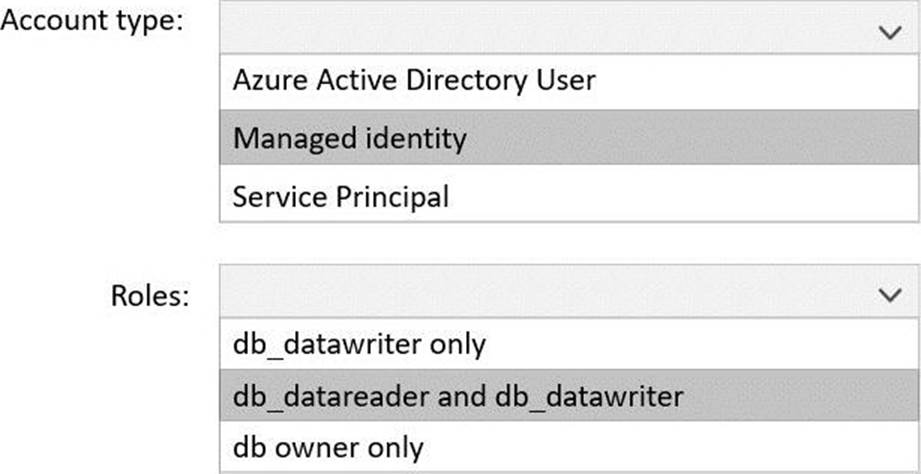
Explanation:
Reference: https://docs.microsoft.com/en-us/azure/app-service/tutorial-connect-msi-sql-database?tabs=windowsclient%2Cdotnet
HOTSPOT
You have an Azure subscription that contains the resources shown in the following table.
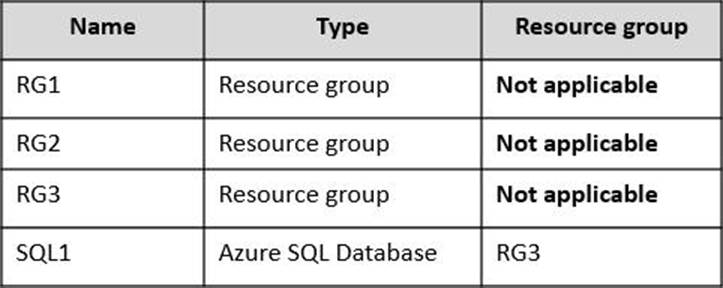
Transparent Data Encryption (TDE) is disabled on SQL1.
You assign policies to the resource groups as shown in the following table.

You plan to deploy Azure SQL databases by using an Azure Resource Manager (ARM) template.
The databases will be configured as shown in the following table.

For each of the following statements, select Yes if the statement is true. Otherwise, select No. NOTE: Each correct selection is worth one point.


Explanation:
Reference: https://docs.microsoft.com/en-us/azure/governance/policy/concepts/effects
You have an Azure subscription.
You need to deploy an Azure virtual WAN to meet the following requirements:
• Create three secured virtual hubs located in the East US, West US, and North Europe Azure regions.
• Ensure that security rules sync between the regions.
What should you use?
- A . Azure Firewall Manager
- B . Azure Virtual Network Manager
- C . Azure Network Function Manager
- D . Azure Front Door
You have an Azure subscription that contains a web app named App1.
Users must be able to select between a Google identity or a Microsoft identity when authenticating to App1.
You need to add Google as an identity provider in Azure AD.
Which two pieces of information should you configure? Each correct answer presents part of the solution.
Each correct selection is worth one point
- A . a tenant name
- B . a tenant ID
- C . the endpoint URL Of an application
- D . a client ID
- E . a client secret
DE
Explanation:
https://learn.microsoft.com/en-us/azure/app-service/configure-authentication-provider-google
